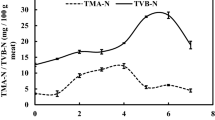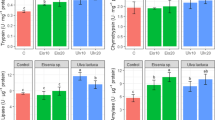Abstract
Microbiological and chemical changes in shrimp Acetes vulgaris during production of Kapi (salted shrimp paste of Thailand) including salting, drying and fermentation were monitored. Moisture content of samples decreased rapidly after salting and drying steps. The lower water activity was found in the final product (0.694). The pH decreased within the first 10 days of fermentation and continuously increased as fermentation progressed. Protein underwent degradation throughout Kapi production as indicated by increasing TCA-soluble peptides and degree of hydrolysis. The increases in peroxide value as well as thiobarbituric acid reactive substances value revealed that lipid oxidation occurred throughout all processes. Total viable count, halophilic, proteolytic and lipolytic bacteria counts increased continuously during Kapi production, while lactic acid bacteria count slightly decreased at the final stage of fermentation. Thus, proteolysis and lipolysis took place throughout Kapi production, and contributed to the characteristics of finished product. These changes were governed by both endogenous and microbial enzymes.




Similar content being viewed by others
References
Akintola SL (2015) Effects of smoking and sun-drying on proximate, fatty and amino acids compositions of Southern pink shrimp (Penaeus notialis). Int J Food Sci Technol 52:2646–2656
Amano K (1962) Influence of the nutritive value of fish with special reference to fermented fish products of southeast Asia. In: Hee N, Kreuzer R (eds) Fish and nutrition. Fishing News, London, pp 180–200
AOAC (2000) Official methods of analysis. Association of Official Analytical Chemists, Washington
BAM (2001) Aerobic plate count. In: Bryce J (ed) Bacteriological analytical manual. U.S. Food and Drug Administration, E-con Publishing, New York, pp 53–67
Bellagha S, Sahli A, Farhat A, Kechaou N, Glenza A (2007) Studies on salting and drying of sardine (Sardinella aurita): experimental kinetics and modeling. J Food Eng 78:947–952
Benjakul S, Morrissey MT (1997) Protein hydrolysates from Pacific whiting solid wastes. J Agric Food Chem 45:3423–3430
Cagdas E, Kumcuoglu S (2015) Effect of grape seed powder on oxidative stability of precooked chicken nuggets during frozen storage. J Food Sci Technol 52:2918–2925
Chaijan M (2011) Physicochemical changes of tilapia (Oreochromis niloticus) muscle during salting. Food Chem 129:1201–1210
Chappe P, Mourey A, Kibertus G (1994) Variataion of lipolytic activity in the genus Acinetobacter sp. J Gen Appl Microbiol 4:103–114
Chung SY, Lee EH (1976) The taste compounds of fermented Acetes chinesis. B Korean Fish Soc 9:79–110
Chuon MR, Shiomoto M, Koyanagi T, Sasaki T, Michihata T, Chan S, Mao S, Enomoto T (2014) Microbial and chemical properties of Cambodian traditional fermented fish products. J Sci Food Agric 94:1124–1131
Faithong N, Benjakul S (2012) Changes in antioxidant activities and physicochemical properties of Kapi, a fermented shrimp paste, during fermentation. J Food Sci Technol 51:2463–2471
Faithong N, Benjakul S, Phatcharat S, Binson W (2010) Chemical composition and antioxidative activity of Thai traditional fermented shrimp and krill products. Food Chem 119:133–140
Fennema OR (1996) Water and ice. In: Fennema OR (ed) Food chemistry. Marcel Dekker, New York, pp 17–94
Hajeb P, Jinap S (2015) Umami taste components and their sources in Asian foods. Crit Rev Food Sci Nutr 55:778–791
Kim JS, Shahidi F, Heu MS (2005) Tenderization of meat by salt-fermented sauce from shrimp processing by-products. Food Chem 93:243–249
Kobayashi T, Kajiwara M, Wahyuni M, Kitakado T, Hamada SN, Imada C, Watanabe E (2003) Isolation and characterization of halophilic lactic acid bacteria isolated from “terasi” shrimp paste: a traditional fermented seafood product in Indonesia. J Gen Appl Microbiol 49:279–286
Latorre-Moratalla ML, Bosch-Fuste L, Bover-Cid S, Aymerich T, Vidal-Carou MC (2011) Contribution of enterococci to the volatile profile of slightly-fermented. LWT- Food Sci Technol 44:145–152
Liu PZ (1989) The umami of Yu-lu. Food Sci (Chinese) 4:37–40
Lizaso G, Chasco J, Beriain MJ (1999) Microbiological and biochemical changes during ripening of salchichon, a Spanish dry cured sausage. Food Microbiol 16:219–228
Lowry OH, Rosebrough NJ, Farr AL, Randall RJ (1951) Protein measurement with the folin phenol reagent. J Biol Chem 193:265–275
Majumdar RK, Bejjanki SK, Roy D, Shitole S, Saha A, Narayan B (2015) Biochemical and microbial characterization of Ngari and Hentaak—traditional fermented fish products of India. J Food Sci Technol 52:8284–8291
Meland K, Willassen E (2007) The disunity of “Mysidacea” (Crustacea). Mol Phylogenet Evol 44:1083–1104
Minh-Thuy LT, Okazaki E, Osako K (2014) Isolation and characterization of acid soluble collagen from the scales of marine fishes from Japan and Vietnam. Food Chem 149:264–270
Mizutani T, Kimizuka A, Ruddle K, Ishige N (1987) A chemical analysis of fermented fish products and discussion of fermented flavors in Asian cuisines. In: Atsushi N (ed) Bulletin of the national museum of ethnology. Osaka, Japan, pp 810–864
Namwong S, Tanasupawat S, Lee KC, Lee JS (2009) Oceanobacillus kapialis sp. nov., from fermented shrimp paste in Thailand. Int J Syst Evol Microbiol 59:2254–2259
Nirmal NP, Benjakul S (2009) Effect of ferulic acid on inhibition of polyphenoloxidase and quality changes of Pacific white shrimp (Litopenaeus vannamei) during iced storage. Food Chem 116:323–331
Pakdeeto A, Tanasupawat S, Thawai C, Moonmangmee S, Kudo T, Itho T (2007) Lentibacillus kapialis sp. nov., from fermented shrimp paste in Thailand. Int J Syst Evol Microbiol 57:364–369
Peralta EM, Hatate H, Kawabe D, Kuwahara R, Wakamatsu S, Yuki T, Murata H (2008) Improving antioxidant activity and nutritional components of Philippine salt-fermented shrimp paste through prolonged fermentation. Food Chem 111:72–77
Phithakpol B (1993) Fish fermentation technology in Thailand. In: Steinkraus KH, Reilly PJ (eds) Fish fermentation technology. United Nation University Press, Tokyo, pp 155–166
Pongsetkul J, Benjakul S, Sumpavapol P, Kazufumi O, Faithong N (2014) Chemical composition and physical properties of salted shrimp paste (Kapi) produced in Thailand. Int Aquat Res 6:155–166
Pongsetkul J, Benjakul S, Sumpavapol P, Kazufumi O, Faithong N (2015) Properties of salted shrimp paste (Kapi) from Acetes vulgaris as affected be post-mortem storage prior to salting. J Food Process Pres 40:636–646
Pongsetkul J, Benjakul S, Sumpavapol P, Kazufumi O, Faithong N (2016) Characterization of endogenous protease and the changes in proteolytic activity of Acetes vulgaris and Macrobrachium lanchesteri during Kapi production. J Food Biochem. doi:10.1111/jfbc.12311
Rodrigo J, Ros G, Periago MJ, Lopez C, Ortuno J (1998) Proximate and mineral composition of dried salted roes of hake (Merltcccircs merluccius, L.) and ling (Molva molva, L.). Food Chem 63:221–225
Sae-leaw T, Benjakul S, Gokoglu N, Nalinanon S (2013) Changes in lipids and fishy odour development in skin from Nile tilapia (Oreochromis niloticus) stored in ice. Food Chem 141:2466–2472
Steel RGD, Torrie JH, Dickey DA (1980) General statistics. In: Steel RGD (ed) Principle and procedure of statistics. McGraw-Hill, New York, pp 457–490
Takeungwongtrakul S, Benjakul S (2013) Oxidative stability of shrimp oil-in-water emulsions as affected by antioxidant incorporation. Int Aquat Res 5:1–12
Tanasupawat S, Taprig T, Akaracharanya A, Visessanguan W (2011) Characterization of Virgibacillus strain TKNR13-3 from fermented shrimp paste (ka-pi) and its protease production. Afr J Microbiol Res 5:4714–4721
Tyn MT (1983) Recent development in nutrition and food technology in Burma. In: Chu S (ed) Burmese encyclopedia. Sarpaybeikhman Publishers, Rangoon, pp 228–253
Zlatanos S, Laskaridis K, Sagredos A (2009) Determination of proximate composition, fatty acid content and amino acid profile of five lesser common sea organisms from the Mediterranean Sea. Int J Food Sci Technol 44:1590–1594
Acknowledgements
Grant‐in‐Aid for dissertation from Graduate School, Prince of Songkla University, Thailand was acknowledged. Authors are grateful for the TRF Distinguished Research Professor Grant.
Author information
Authors and Affiliations
Corresponding author
Rights and permissions
About this article
Cite this article
Pongsetkul, J., Benjakul, S., Vongkamjan, K. et al. Microbiological and chemical changes of shrimp Acetes vulgaris during Kapi production. J Food Sci Technol 54, 3473–3482 (2017). https://doi.org/10.1007/s13197-017-2804-4
Revised:
Accepted:
Published:
Issue Date:
DOI: https://doi.org/10.1007/s13197-017-2804-4




